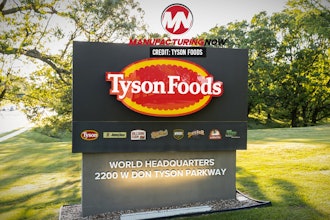
DENVER (AP) — Holly has only been working at the Good Times Burgers & Frozen Custard on Broadway since January. But she's already the sixth most tenured among 15 to 20 employees at the Denver location on any given day.
She's also not a she. Or he. Or they. Holly is artificial intelligence developed by a Denver company called Valyant AI. The AI handles the drive-thru breakfast orders so human employees can make the food, take payments and do all the other things fast-food employees must do. "It gives us time to focus more on what we need to focus on so we're not as far behind," said Melissa Deffenbaugh, an assistant manager who started at Good Times a year before Holly. "It makes the day go a little bit smoother."
But sometimes, Deffenbaugh or another employee must step in when Holly doesn't understand the customer. Someone is always monitoring Holly to make sure the order is right. And on some days, even Holly doesn't show up for work because there's been a computer glitch or the system went offline.
The sci-fi thrill of artificial intelligence has exited the lab and exists today in a more mundane environment, where mistakes are still made, humans are still involved and sentient AI is still fictional. Many consumers already experience AI in tools like online tech-support or customer-service chats, anti-malware software and malware, or home assistants like Amazon's Alexa or Apple's Siri.
The reality is that we're still a long way from Rosie, the cartoon robot in "The Jetsons" that conversed with humans thoughtfully and with personality. The industry is far from there, but is working on those next steps to make AI so reliable that companies like Good Times can tap the promise of speed, accuracy and economic benefits, such as addressing the worker shortage.
"If you have a robot with the dexterity to lift a glass out of your sink and put it in the dishwasher, that's awesome," said Rob Carpenter, founder and CEO of Valyant AI, which partnered with Good Times to perfect a virtual ordering system. "But you also have to tell it cups go on the top, silverware goes in these little trays."
Valyant is working on the communication part, or conversational AI. Others are working on other software or hardware, like the parkour-jumping robot from Boston Robotics or the personal robots coming soon from Boulder's Misty Robotics.
"But ultimately for us or any company building a truly enterprise-grade conversational AI system, it's going to have to do the actual thing," Carpenter said. "It will help check you into a hotel room, it might help you fill out a home loan application, maybe it'll check you into your doctor's appointment, you name it. I think over the next decade we'll see the services start proliferating. This is purely the tip of the iceberg."
Holly was installed at the Good Times drive thru in September and started taking real orders in January. (She's on daily between 8:30 and 10:30 a.m.) She recently began working a lunch shift, though she doesn't start until after the rush, or sometime around 2 p.m.
It's been rough, Carpenter admitted. Accents and slang can get in the way. Humans often speak in a stream of consciousness and aren't clear or direct. Combo meals, for example, can be especially tricky.
"The challenges we run into is someone will say, 'Can I have a number two and the number one? No tomatoes on the first one and a Dr. Pepper on the second,'" Carpenter said. "But the first thing they asked for was a number two, then they said modify the first one, which is the number two, and the second one, they said, 'I want a Dr. Pepper on the first one.'"
As a human, did you even get that?
Holly starts chatting when a customer drives up. She's the software in a computer next to the cash register. Whatever she hears is sent to Valyant's network in the cloud, translated to text and fed into a natural language processor where the meaning is pulled out. Valyant's logic engine finds patterns and meanings to figure out what the customer wants and whether more questions need to be asked. Then it translates the text back to audio and Holly responds to the customer. All within a few seconds.
She learns every time a customer orders in a different way. Holly has "collected and processed north of a million phrases" since training began, Carpenter said.
That's typically how AI learns. Over in Douglas County, Dish Network just added Google Assistant to its TV hardware (it already worked with Alexa). Dish relies on Google to train its assistant to understand customer questions beyond the scope of changing channels or controlling the TV. Google's AI responds to commands like "Show me movies from the '90s."
But Dish engineers must train Google's AI anytime it doesn't understand commands relevant to the TV customer experience.
"We make sure the experience stays up to date. If Dish gets a new channel, that's something Google won't have the knowledge of," product manager James Wilde said. "If someone were to find a new way to change the channel that neither of us had thought about, that would be a way for us to say (to Google), 'Hey, we missed this verb.'"
AI is based on an inordinate amount of data. Denver-based Orderly Health, for example, helps insurance companies keep accurate directories of their doctors. The old way was to hire someone to call the doctor's office or send a postcard, a slow and tedious process. But by cross referencing available databases, Orderly Health can do the job faster, more accurately and at a lower cost with the help of its machine-learning AI technology to find mistakes.
"There is no such thing as sentient AI right now," said Kevin Krauth, Orderly's CEO and co-founder. "All the AI that people talk about right now is behavioral mimicry. It's imitating intelligence by using mathematical models and logical approaches. It's not like the computer understands language, but the frequency with how words are paired together and how those translate into meaning. Valyant is saying if these words are strung together, then do this. We're doing something similar. We're seeing all the signals from all these data sources about this particular data record and that gives us confidence about whether it's right or wrong."
Holly is more of a chatbot, which is programmed to converse like a human. Chatbots are common for online customer service where customers type in their requests in text boxes and get a reply. Facebook Messenger uses them to give businesses an automation tool to respond to customer questions.
But even chatbots have their bad days. Remember Microsoft's Tay, a chatbot that was supposed to learn from conversations? Tay showed up on Twitter in March 2016 and online users began tweeting misogynistic and racist tweets at it. Within 24 hours, the uncensored Tay replied with racist remarks and foul language and Microsoft silenced the bot to make adjustments.
"The first time chatbots came into being, people said they would replace human conversation. There was a lot of promise. But then what happened, there was a lot of blowup on the PR side. It wasn't working," said Brian Sathianathan, chief digital officer at Iterate, a Denver firm that helps retailers integrate technology like AI. "But then all these chatbots trained to a specific problem or did a human handover when the artificial intelligence could no longer address the human's needs. And now, all the AI chatbots transfer gracefully to a human."
The goal is to get to what is known as general AI, or a system where AI responds to anything and everything, as a human would. But right now, he said, the reality is what is called specific AI, like Holly. She only needs to learn one thing: How to accurately take a Good Times customer's breakfast order.
"The reasons why these things work really well is that it's specific to a given domain. If it's trained on that question, it works really, really well," Sathianathan said. "That's why Valyant may take iterations to get it right, but once they get it right, they can duplicate it."
The fast food industry is struggling to not only hire workers but keep them. According to Dallas-based restaurant research firm TDn2K, worker turnover is at a record high with 30 to 40% of companies reporting an increase in unfilled positions for the past two years. "From all of our recent research we can assure you that of all segments, QSR (quick serve restaurants, or fast food) is the one under the most distress," Sarah Atkinson Higgins, TDn2K's vice president of marketing, said in an email.
AI is seen by the industry as a tool that could relieve some of those pressures, especially in fast food where customers typically drive up and converse with a voice, not a face, said Sam Oches, Editorial Director of Food News Media, which publishes QSR magazine. "This is going to be the future of the fast food ordering experience," Oches said. "You can essentially remove a whole employee there to only take orders from cars."
McDonald's is another chain investing in artificial intelligence. The company paid $300 million in March for Dynamic Yield, a smart display boards maker. The displays change the menu based on weather, time of day, nearby events or the customer's order (It could assume a Happy Meal order at 5 p.m. means an adult is ordering for their kids and could be tempted by a snack or coffee, suggests Wired magazine). The company has rolled out the technology to 700 restaurants nationwide, reports Nation's Restaurant News.
"You can absolutely save on labor and replace humans (with) technical components that are arguably going to do a better job," Oches said. However, he added, "They haven't replaced the human, just assisted them with AI. You still have to have a person to make the food."
Georgia-based 5Thru is a close competitor to Valyant. It mixes mobile ordering with cameras that use AI to recognize the driver's license plate. That can speed up the order, but that personal familiarity by a fast-food chain is unnerving to some and that can be a privacy issue. "WE HAVE SEEN EVERY EPISODE OF BLACK MIRROR," writes Jelisa Castrodale in a story about it for Vice.
"It's a Big Brother step," Oches said. "Society will have to collectively figure out if we're OK with that."
For now, Good Times and Valyant, which has raised about $3.2 million from investors that include NRD Capital, are hoping to roll out video screens to help customers verify orders and ease into ordering from Holly. By programming Holly to suggest additional items to customers, that's led to higher than usual suggested orders. And despite employees stepping in occasionally when Holly doesn't understand something, the company finds employees are more efficient and the company is seeing a nice return, said Scott LeFever, the company's chief operating officer.
"We've gained in speed of service," he said. "But not because she's fast at taking the order, she's not as fast. But she's doing the job so a person can prepare the food."
Good Times still has to keep employees trained on ordering, in case Holly conks out, but having AI take over human tasks has sped up service 10 to 25%, according to Valyant. And once Holly conquers dinner and lunch with high accuracy, the company won't have to train her sisters who could be rolled out to the other 34 Good Times that are mostly in Colorado.
"It's hard to tell how people react to it. That's why we have the option to talk to someone. Initially, 10% opted for the human, now it's down to 3% are opting for the human," LeFever said. "It's showing that people as they use it are becoming more comfortable and are seeing it as more of a convenience than a hindrance."





















